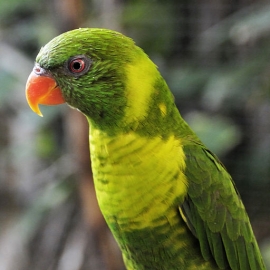Flores Lorikeet |
|
|
Also known as: Leaf Lorikeet
Species Profile
Genus: Trichoglossus | Species: weberi
Size:
25cm (10 in)
Weight:
100-150g (3.5-5.0 oz)
Subspecies including nominate:
one
Colour Adult:
Both adults in general green; light green/blue streaking on forehead and lores, the remainder of head streaked with brighter green; yellow/green underwing coverts; smaller in size.
Colour Juvenile:
As in adults.
Call:
Repeated notes, sharp, rolling while in flight. Shrill chattering while feeding. Soft notes at rest.
Video Links:
Video 1More Information:
Content Sources:
BirdLife International
Cornell Lab of Ornithology/Birds of the World
xeno-canto Leaf Lorikeet, Drijvers, Raf, XC350575
Parrots in Aviculture, Low, 1992.
Species Care
Captive Status:
Rare
Longevity:
Not recorded.
Housing:
Enclosure with drain in floor, or suspended cage over tiled or concrete floor.
Diet:
Nectar - a commercial type specially formulated for small species or a mix of baby cereal (lactose-free) and honey, malt extract or molasses, mixed with filtered water, made fresh once or twice daily, making up at least 40 percent of the diet; vegetables and fruit especially apple, pear, orange, cactus fruits and bananas, and one or more daily of: carrot, fresh corn, green leaves; plus dried figs soaked in water for a few hours, spray millet and a small amount of soaked or sprouted sunflower seed and small amount of canary seed.
Enrichment:
Loves bathing, hanging toys, puzzle/foraging toys, foot toys, ladders, swings, socializing; noisy toys (bells, squeakers), bird safe chewables (vegetable tanned leather, safe woods).
Nest Box Size:
L-shaped box, 51cm x 36cm (20 x 14 in).
Clutch Size:
2 to 3
Incubation Time:
23-25 days
Fledging Age:
8-9 weeks
Hatch Weight:
Presumed to be 5g (0.2 oz)
Peak Weight:
Not recorded.
Weaning Weight:
Not recorded.
Specialist Club:
Species Wild Status
World Population:
10,000-20,000, decreasing.
IUCN Red List Status:
Near Threatened
CITES Listing:
Appendix II
Threat Summary:
Not globally threatened. Population is considered to be declining, but information is lacking. Habitat destruction through firewood collection, commercial logging, timber extraction for construction materials and clearance for agriculture is the most important threat. There is little or no governmental enforcement of laws. Trapping for the wild bird trade may represent a further threat.
Range:
Occurs on Flores, Lesser Sunda Islands.
Habitat:
Most common in lowlands but found up to 2400m (7872 ft). Wide variety of areas including settlements, forest, coconut plantations, savanna, Eucalypt stands and mangroves.
Wild Diet:
Feeds mainly on nectar but will also take figs, insects and can be found around man-made feeding stations.
Ecology and Behaviour:
Found in mixed flocks with other parrots; in small noisy groups. Nomadic, as they are dependent on flowering trees. Roosts communally in groups of hundreds of birds. Will also roost and nest on the ground on some of the predator-free islands. Displays frequently.
Clutch and Egg Size:
2-3 ovate eggs, 27.0 x 22.5mm (1 x 0.9 in).
Breeding Season:
February-August.
Members Only Resources
Please log-in now to find more research, resources and tools.
Not a Member?
Find more great information:
Gain exclusive access to 600+ pages of additional research, seminars and podcasts, specialists to ask your toughest questions, and dozens of other fun resources - when you become a WPT member.
Join Today >>

































